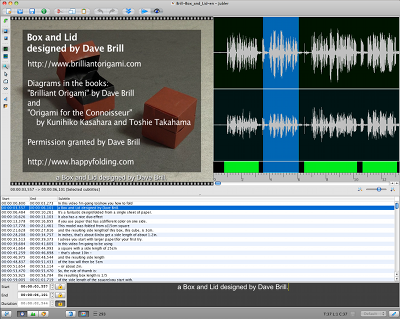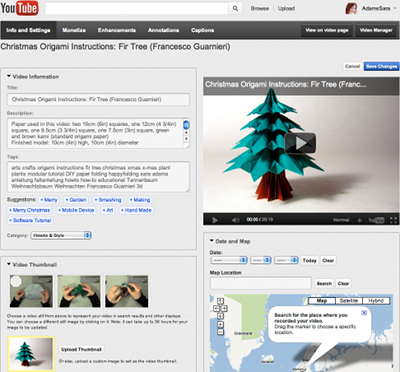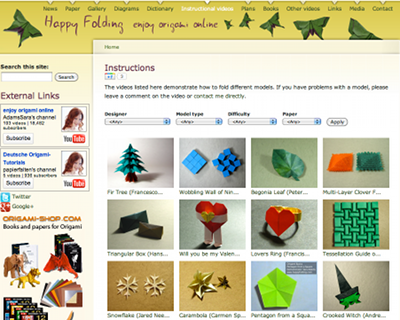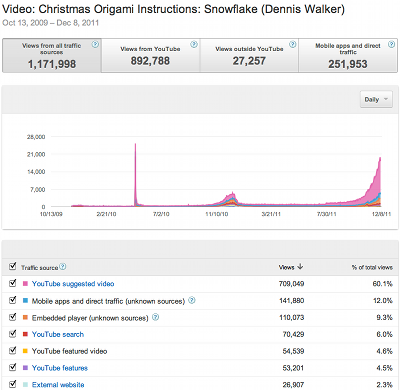We're almost there! After making the video, which includes asking for permission to make an instructional origami video, preparing yourself for recording the raw material, recording it, and then editing it, there's just a couple more things to do.
First, consider adding subtitles to your video to make it more accessible. Then make the video available. And finally let others know that your awesome new video is waiting to be viewed by them. This article will outline how I go about these tasks, and thus finish the process I go through for my videos. As always, this is not the one and only way, but may help you get an idea on what has worked for others, and particularly me.
Resources Used
For a quick overview, here are all the important links to the resources I use and describe in this article.
- Software Jubler (free download, cross-platform)
- This is the program I use for creating closed caption files to add subtitles to my videos. I did explore a couple of different programs, and found this one to be the one I could work with best. Obviously, there are many other programs out there, which offer similar features.
- Video platform YouTube
- There are many ways in which you can publish your videos. I upload my videos to YouTube, currently to the channel AdamsSara (English) and less frequently to the channel papierfalten (German). There are many similar video platforms out there, or you might want to host your videos yourself or, indeed, sell them on a DVD.
- Website www.happyfolding.com
- About 3 months after I uploaded my first video, I also launched my website www.happyfolding.com. It's the one place where I try to bring together my online contributions to the origami world. Obviously, if you make your content accessible, you will post it on a different website. But as explained later on in this article, there are a couple of reasons why adding information on your videos to your website is a good idea - be it an existing website, or one you just created.
- Origami Database
- Dennis Walker started an origami database in 1992, and it's been steadily growing since. It's a great way to find diagram sources for many models. I've added an entry for my website, so that both the the diagrams I host and the videos I've posted can be discovered easily when searching for model instructions.
- Mailing lists
- Whenever you put new origami content out there, it's good to let the community know. One of the most direct ways of reaching them is via email, and thus I do send announcements to some mailing lists, namely the Origami-L mailing list, members@origamiusa.org (Origami USA members only), BOSmail (BOS members only) and papierfalten (German).
- Origami Forum
- Although it started more as a thread on finding out which models other origami enthusiasts were most keen to see a video on, Sara's video thread in the Origami Forum quickly got the addition of me also announcing which videos I'd just made available. There are many other origami forums out there, especially for different languages, but the Origami Forum is definitely one of the larger and well frequented ones.
- Social networking services
- Along similar lines, you can advertise your videos more publicly on social networking sites. I started this when someone created a Facebook page for my project and I decided to take it over (or rather contribute my comments), later added Twitter to the list, and most recently started using Google+.
I will mention that this list has changed and expanded over time. Some resources I tried, found them not to match my needs, and disregarded. Others I found to be useful and thus kept. If you want to publish videos, or indeed other origami work (such as diagrams) online you will surely find your own set of resources that work best for you. These may give a good starting point, though. And with that, I'll start explaining what roles these resources play.
Adding Closed Captions
Motivation
First off, adding closed captions takes substantial work. You should weigh off whether you think it enhances your video sufficiently to be worth the effort. My biggest motivation is making my videos more accessible, and there are actually a couple of groups of viewers who profit from subtitles:
- Viewers that are hearing impaired
- The verbal instructions I give help viewers follow my videos. But what if you are deaf, or hard of hearing? Making my videos more accessible to those affected is surely my greatest motivation.
- Viewers with only basic English skills
- Yes, I have an accent. And maybe I sometimes don't speak clearly enough, mispronounce words or use strange constructions. Being able to read what I said helps people with less proficient English language skills understand it. Plus, when I add subtitles I sometimes correct grammatical mistakes or slightly restructure the sentence. I do try to keep this at a minimum, but sometimes what I said is just too painful to put in writing.
- Viewers who don't know English at all
- One of the great things about adding captions is that once you've written them (including the timing information), they can easily be translated into other languages. For example, I have translated most of the captions I added into German. And viewers have volunteered to translate captions for some of their favorite videos. So some of my videos also have subtitles in languages such as Bulgarian, Portuguese, Suomi and Arabic.
- Viewers who prefer muted videos
- It doesn't really matter why, but some viewers prefer watching my videos without sound. I do know that some people don't like the sound of my voice (when posting to YouTube you quickly develop a thick skin), and others are sometimes in an environment where sound is disruptive. Captions make the spoken instructions accessible to these viewers, too.
Process

Adding closed captions is accomplished by creating a text file, which includes the captions and information on when to show each caption. There are different file formats that are widely supported. I've thus far worked with one I perceive to be quite simple, SubRip (*.srt). This format makes it easy for me to send the files to viewers that generously offer to translate the captions into other languages, as they can use a basic text editor and only need to replace the English strings.
There are also many programs that help you create such files. In particular, the first file, for which the timing information has to be added, is much easier to create if you have a program that offers a graphical interface showing the video and/or the audio track in waveform. When I started adding subtitles, I first tried to create the files without using a special program and quickly discovered it was extremely time-consuming. After taking a look at a few of programs, I decided that Jubler was the one I liked working with most. It allows you to import a video and then shows you the audio waveform. You can then mark specific areas of the audio track, and simply type the text you want to have shown during that sequence. The waveform clearly exposes where there are speech pauses, and you can play back only the marked area to check whether you are happy with the selection you have made.
Examples
As mentioned earlier, adding captions does take work, and for me it's quite a boring task. So while I have added captions to some of my videos, I haven't done so for all of them. My first attempt at adding captions was for Charles Santee's Kaleidoscopic Twister, but I found it to be so much work that I didn't finish the whole video. In April 2009 I tried again, this time using Jubler, and the result was a fully subtitled video for Neal Elias' "Last Waltz". I never went back and added subtitles for older videos, but did start adding captions more regularly starting from March 2010 onwards. Above you'll find a playlist with all the videos that I did add captions to. There are currently videos for 15 different models in that set.
I will note that in some cases I have special motivation to add subtitles, namely, I recorded some videos with German spoken instructions. For these I decided to always add captions and at least translate them to English. The main motivation here is that many more people understand English than German and having English captions will make the videos accessible to a much wider audience.
Publishing Your Video
There are various ways in which you can make your video available to others. I'll first explain how I do this specifically, and then draft a couple of other ideas.
Uploading to YouTube

At least thus far I've only uploaded my videos to online video platforms. While I did explore other platforms in the beginning, I currently only upload videos to YouTube (to an English channel AdamsSara and a German one, papierfalten). One of the reasons is that YouTube is a very popular site, and that having videos on there make my videos very discoverable, either via search on YouTube itself, or on web search engines. YouTube also has some nifty features, which I use extensively. For example, there is support for subtitles, it offers statistics on viewing behavior and video discovery, and you can monetize your videos by showing ads to viewers.
Uploading the video itself is easy enough, although — depending on how big your file is and how slow your internet connection is — it may take a while. More importantly, though, the job doesn't stop there. There's metadata that you can and should add:
- Title
- At the bare minimum, you should add a meaningful title. At least recently, I've used the same pattern for the titles of my main instructional videos, "Origami Instructions: [Model Name] ([Designer])".
- Description
- The next step is to add a good video description. For example, I include a recommended paper size, thank the designer for giving me permission to demonstrate the model, and add links to important pages (such as the designer's website, where to buy a book that includes diagrams, online diagrams).
- Tags
- I also add tags, which are basically words for which you can also search to potentially find the video. I have a predefined set of tags I use on all videos and then some, which are specific to the model (e.g. the designer's name).
- Thumbnail
- When others search for videos, the first thing they'll probably see is the thumbnail of the video. In the beginning I could not upload separate images for the thumbnail, but did make sure to pick the best thumbnail of the three I was offered. These show different frames of the video uploaded. Once the feature was supported in my account, I went on to upload images of the finished model instead. This lets potential viewers judge quickly whether they like the look of the model, and may drive more viewers to your videos.
- Subtitles
- If you put in the effort of creating closed captions files, you should make sure to add them to your video. Viewers will be able to activate or deactivate them, and - if you have subtitles in different languages - switch to their preferred language.
Other Options
As mentioned earlier, I didn't always upload videos only to YouTube. When I started, I mainly uploaded videos to Metacafe, but at one point their guidelines changed and I moved away from it. It's probably noteworthy that there aren't just many video platforms out there in general, but also some specifically for origami, e.g. OrigamiTube. You can also host your videos on your own website. Like this, you have full control over the content. However, there are some disadvantages, such as your videos being less discoverable, or - if the videos do get very popular - them causing lots of traffic to your site and thus, real costs.
But of course there aren't just online options. You can also create CDs or DVDs and sell them. For example, Chris Palmer has a couple of CDs available on his website, shadowfolds.com (such as for his amazing Flower Tower). Or if you are publishing a book, adding a CD with some video instructions may help the book stand out. For example, Peter Engel made some videos for his most recent publication Origami Odyssey.
No matter which option you chose to publish your videos, each has its advantages and disadvantages. For me it's currently only online video platforms, but it may well be that I'll also look into selling content some time in the future.
Publicizing Your Video

First off, for the fifth issue of The Fold I wrote an article on Publicizing Books Online. Much of what I wrote there also applies to videos. So I will try to not be too repetitive, and keep this section short.
Announcements
When you publish a book, your publisher will invest some energy into getting the message out there. When you publish yourself, this lies solely in your hands. And you will want to reach as many people as possible that you think will find your video enjoyable. This means that using different options is often a good idea. In the resources section I already listed some resources I use. It's noteworthy that these do address different target audiences. For example, sending an email to a mailing list usually reaches people active in the origami community and perhaps more dedicated folders. In contrast, posting on social media websites reaches a somewhat younger audience (on average) and folders that aren't necessarily part of an origami society, or for whom origami is mostly a pastime. Posting to my website reaches a quite general audience, but one which probably is already aware of my other work.
Discoverability

The biggest issue with all online content is discoverability. Yes, you will want to announce your video to get things started. But as time passes the announcements are forgotten. So the biggest traffic source will be through search.
This is my main motivation for adding entries to the Origami Database, as origami enthusiasts will be able to find my instructions when searching for a specific model or theme. And it's also why I like having my website. There I can add extra information, and once someone's on my site it will make it easier for them to discover other content I created. Finally, it's why it's so important to add meta information to the video itself if you upload it to an online video platform.
This is also why uploading your video to a popular video platform can pay off greatly. The best example is probably my most popular video thus far. It features Dennis Walker's snowflake and recently reached 1 million views. While this is an astonishingly large number of views there are videos by other origami YouTubers with even more views than that. More importantly, though, it's interesting to see where most of the traffic to the snowflake video comes from. YouTube keeps track of such data and makes it accessible to video owners, so I can give you some insight. Most of the traffic to this video came from YouTube suggesting it as a video you might also enjoy watching. Such suggestions can only be made if the metadata attached to the video implies it matches your previous viewing behavior. And of course this only works if lots of people do watch videos, which are related to your video. Thankfully, YouTube has a huge user base and enough people seem to enjoy origami videos or more generally videos around arts and crafts.
And So It Ends
OrigamiUSA's theFold launched one year ago. And with that I also started writing my video creation guide. In six articles I mused about my process in making high-quality instructional videos, and what I learned. I hope you enjoyed this guide, and perhaps it has inspired you to give it a try yourself. Or, if you've made videos before, perhaps you could draw something from the guide to change your own process. Or, of course, it may have simply given you some insight want kind of work (and how much of it) is involved in making such origami videos. In any case, I hope you enjoyed the ride!
